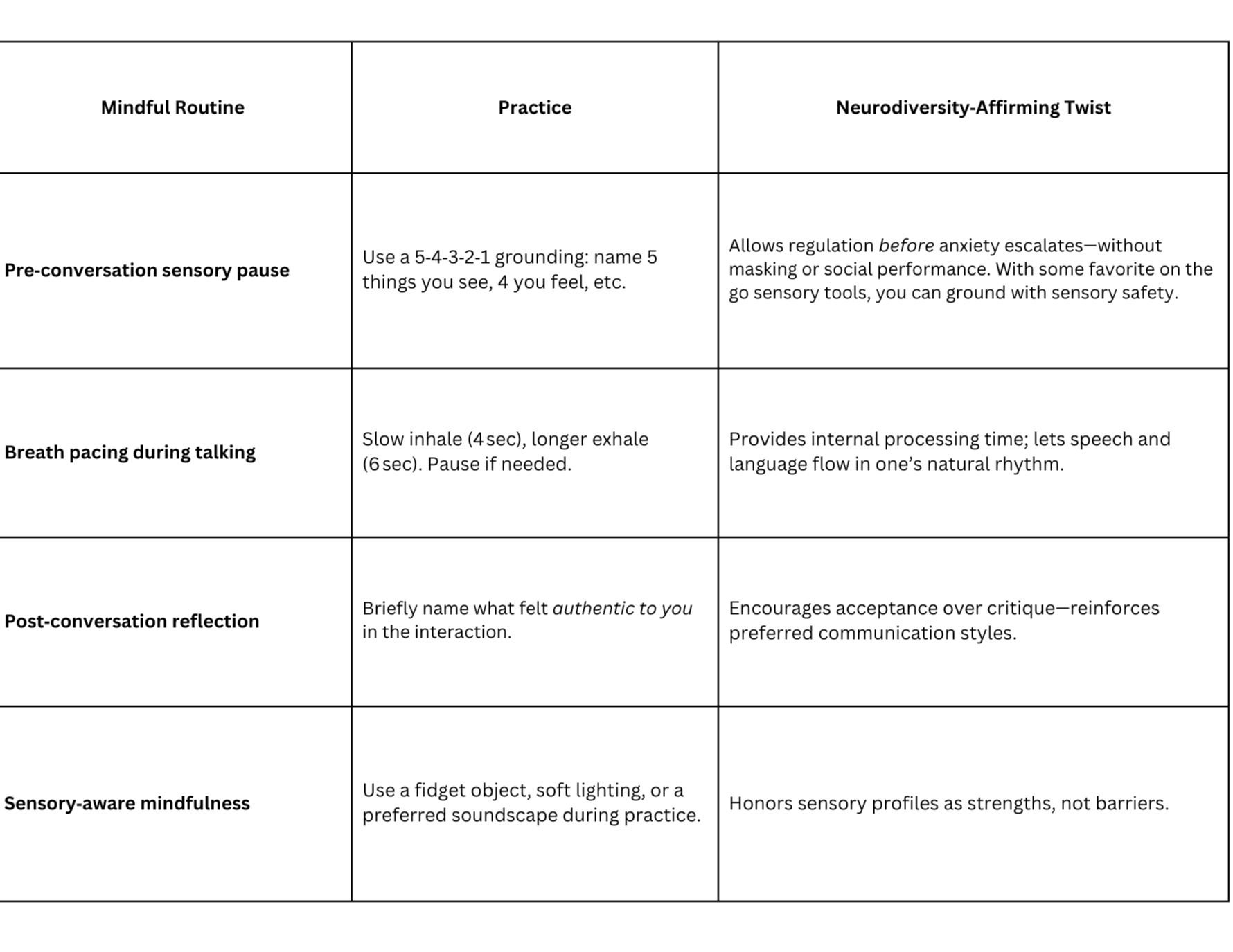Speaking with Ease: Mindfulness Meets Neurodiversity‑Affirming Communication
Written by Devon Brunson, MS, CCC-SLP, CBIS
Imagine preparing for a meeting, your mind racing with worries: “Do I need to script my words? Should I tone down stimming?” Anxiety builds, and the threat of masking— and speaking inauthentically—feels real. What if there were a way to quiet that inner critic and honor your natural way of communicating? That’s where a mindfulness approach rooted in neurodiversity-affirming values comes in—helping autistic individuals manage anxious thoughts and feelings while preserving authentic voice and expression.
Why Mindfulness Works-And Why It Matters.
● A randomized controlled trial (MIT, 2025) found that just 10–15 minutes per day using a mindfulness app significantly reduced anxiety and stress in autistic adults, with benefits lasting for several weeks (Mindfulness).
● A feasibility study of adapted Mindfulness-Based Stress Reduction (MBSR) showed reduced stress and improved coping skills in autistic adults, with a 79% completion rate and no adverse effects (Autism).
● A broader systematic review found a significant effect on reducing anxiety, depression, rumination, and improving attentional and executive functioning in autistic adults using adapted mindfulness programs (Review Journal of Autism and Developmental Disorders, Brain Sciences).
Together, these findings highlight that mindfulness practices can be practical and meaningful when paired with a respectful, autistic-centered design.
What Neurodiversity Mindset Looks Like
Contrary to interventions that push masking or normalize speech patterns, a neurodiversity-affirming approach:
● Centers autistic leadership and feedback, tailoring sensory input, pacing, and language to support autonomy.
● Respects communication styles rather than forcing them into neurotypical norms. The goal isn’t to eliminate stimming or fix prosody—it’s to build self- awareness, confidence, and clear expression grounded in identity.
Mindfulness Strategies For Daily Life Integrating Into Daily Routines
Rather than prescribing therapy-only exercises, here’s how to weave these practices into everyday life:
Morning ritual: Begin the day with a 5-minute grounding practice to awaken the senses (e.g., noticing breath while sipping tea) as a “warm-up” for intentional communication
Phone calls or meetings: Do breath pacing before dialing in; pause mid-conversation if feeling overwhelmed—and return at your own pace. How you choose to enter or re-engage in communicative interactions may be based on other external constraints beyond your control, so do what feels best for you in the moment.
Evening reflection: Keep mindfulness simple—jot down one moment that felt true to your voice, without judgments.
On-the-go support: Use an app of choice (like Insight Timer) or short guided audio—with captions and pacing controls—to cue mini-grounding practices during transitions (e.g., between errands, before appointments).
Over time, these little routines help form habits - and that’s the real power of mindfulness! It sticks with you even outside of routine practice. As research has shown, people often keep feeling the benefits of mindfulness practices long after they have stopped using them regularly.
Why It’s A Communication Tool-Not Just Self-Care
As mindfulness becomes a part of your routine, you may notice that conversations feel much lighter and easier. There is less pressure to script everything or hide parts of yourself just for the sake of “pushing through”. Your natural way of speaking - whether that includes certain rhythms, word choices, or even stimming - can come through more freely. You might also feel more comfortable asking for what you need, like requesting written instructions or choosing a sensory-friendly setting for a conversation.
A partnership between mindfulness and affirming communication shifts the goal: Not to make speech or language sound more typical, but to reduce internal noise so authentic communication emerges. The goal isn’t to make speech sound “more typical” or to push into a communication style that isn’t natural. Instead, it’s about quieting the background noise - like racing thoughts, anxiety, and pressure to perform - that can get in the way of genuine expression. With less of that noise, it’s easier to let your own voice shine through. It also means that any energy you used to spend on masking can be redirected toward connection, allowing you to share your interests, ideas, and perspectives in ways that are comfortably authentic.
An Invitation-
Practicing mindfulness doesn’t require masking the self. On the contrary, it gives autistic communicators space to express who they truly are, with less anxiety clouding speech, language, or social connection.
Try one small step: before your next conversation, pause and notice your breath or sensory surroundings. Then allow yourself to speak—not perfectly, but genuinely.
Articles
Li, C. E., Wang, K. L., Treves, I. N., Bungert, L., Gabrieli, J. D., & Rozenkrantz, L. (2025, April 8). Smartphone Mindfulness Intervention Reduces Anxiety Symptoms and Perceived Stress in Autistic Adults: A Randomized Controlled Trial. Springer Nature Link. Retrieved August 19, 2025, from https://link.springer.com/article/10.1007/s12671-025-02558-z
Aguis, H., Luoto, A. K., Backman, A., Eriksdotter, C., Jayaram-Lindström, N., Bölte, S., & Hirvikoski, T. (2024). Mindfulness-based stress reduction for autistic adults: A feasibility study in an outpatient context. Autism, 28(2), 403-414. https://doi.org/10.1177/13623613231172809
Forbes, Z.N.M., Miller, K. Mindfulness-Based Stress Reduction in the Treatment of Adults with Autism Spectrum Disorder: a Systematic Review of Interventional Studies. Rev J Autism Dev Disord (2023). https://doi.org/10.1007/s40489-023-00398-y
Simione, L.; Frolli, A.; Sciattella, F.; Chiarella, S.G. Mindfulness-Based Interventions for People with Autism Spectrum Disorder: A Systematic Literature Review. Brain Sci. 2024, 14, 1001. https://doi.org/10.3390/ brainsci14101001 (n.d.). Insight Timer. Insight Timer. Retrieved August 19, 2025, from https://insighttimer.com/



